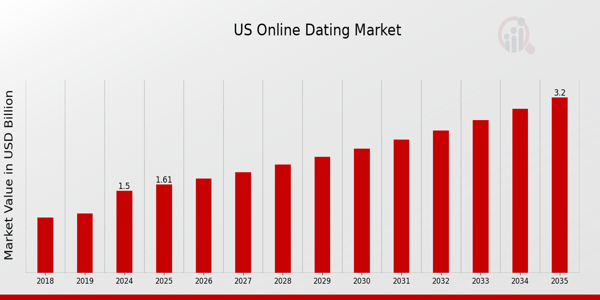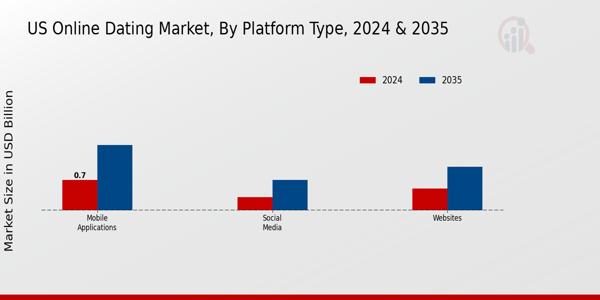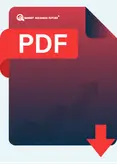US Online Dating Market Overview
As per MRFR analysis, the US Online Dating Market Size was estimated at 1.29 (USD Billion) in 2023.The US Online Dating Market Industry is expected to grow from 1.5(USD Billion) in 2024 to 3.2 (USD Billion) by 2035. The US Online Dating Market CAGR (growth rate) is expected to be around 7.131% during the forecast period (2025 - 2035).
Key US Online Dating Market Trends Highlighted
The US Online Dating Market has been experiencing significant transformations, driven by changing societal norms and the increased acceptance of digital interactions. One of the critical market drivers is the growth of mobile technology, enabling users to access dating platforms conveniently and on-the-go.
This has led to a surge in the use of dating apps, particularly among younger generations who prefer instant connectivity. Moreover, safety features and verification processes have become a focal point for platforms in the US, responding to users' demand for secure and genuine connections. Opportunities within this market are emerging from the integration of artificial intelligence and machine learning.These technologies enhance match-making algorithms and personalize user experiences, making it easier for individuals to find compatible partners.
Additionally, niche dating sites catering to specific interests, lifestyles, or communities are gaining traction, representing a shift towards inclusivity and diversity that many users in the US value.
Trends in recent times reflect a growing popularity of video dating features, as the pandemic shifted how people interact and connect. Users are increasingly utilizing video calls as a preliminary step in their dating journey, allowing them to establish a connection before meeting in person. This has also given rise to virtual dating events, where singles can mingle in a structured environment, fostering community and connection.
With the continuous evolution of social dynamics and technology, the US Online Dating Market is likely to see further innovations and changes, providing a vibrant landscape for users seeking romantic connections.

Source: Primary Research, Secondary Research, MRFR Database, and Analyst Review
US Online Dating Market Drivers
Rising Internet Penetration and Smartphone Usage
The increasing penetration of the Internet and the widespread use of smartphones have been significant drivers of growth in the US Online Dating Market Industry. According to the Federal Communications Commission (FCC), around 97% of Americans now have access to high-speed Internet, which facilitates online interaction and connectivity. Additionally, the Pew Research Center reported that approximately 85% of adults aged 18 to 29 own smartphones.
This technological advancement allows users to access various online dating platforms easily, making it more convenient for people to meet potential partners.As more individuals utilize these platforms, the demand for online dating services is expected to rise significantly, contributing to the growth of the US Online Dating Market Industry. The ability to reach a broader audience through mobile applications and websites will continue to propel the market forward, tapping into the evolving digital lifestyle of consumers.
Changing Social Norms and Attitudes Towards Online Dating
As societal perceptions of online dating evolve, it has increasingly become a socially acceptable way to meet partners, especially among younger demographics in the US. A survey conducted by the Pew Research Center indicated that 30% of adults reported having used a dating site or app, a significant increase from past years.
This shift in attitude is further influenced by high-profile endorsements from celebrities and public figures, which promote online dating as a legitimate avenue for relationships.As these perceptions continue to transform, the US Online Dating Market Industry is likely to see increased participation among various age groups, leading to sustained market growth.
Impact of the COVID-19 Pandemic on Dating Preferences
The COVID-19 pandemic has dramatically reshaped behaviors and preferences related to dating in the US. During the pandemic, many individuals turned to online dating due to social distancing measures and lockdowns. Online dating platforms experienced a surge in users, with reports indicating that usage rates increased by approximately 70% during peak lockdown periods.
This shift has led to a greater acceptance of virtual interactions as a substitute for traditional dating methods.As people have adapted to these new circumstances, the trend is likely to persist even post-pandemic, solidifying the role of online dating in the broader dating landscape and reinforcing growth in the US Online Dating Market Industry.
Diverse Niche Dating Platforms Catering to Various Preferences
The emergence of niche dating platforms that cater to specific interests, lifestyles, or demographics has created new opportunities within the US Online Dating Market Industry. For instance, platforms targeting the LGBTQ+ community, people with specific religious affiliations, or individuals interested in particular hobbies have gained traction. According to a study published by the Community Marketing and Insights, the LGBTQ+ dating segment has grown by over 25% in recent years.This trend demonstrates the market’s evolving nature, where consumers seek more personalized and tailored dating experiences, thus driving growth.
As more niche platforms proliferate, they will contribute to the overall increase within the US Online Dating Market Industry.
US Online Dating Market Segment Insights
Online Dating Market Platform Type Insights
The US Online Dating Market showcases a diverse array of platform types, including Mobile Applications, Websites, and Social Media, each contributing uniquely to the market dynamics and user engagement. The rise of Mobile Applications has transformed the dating landscape, providing convenience and accessibility to users. As smartphones gain popularity, these applications have become the primary method for connection, enabling users to communicate and meet potential partners on-the-go.
Websites also play a significant role, offering users in-depth profiles and compatibility algorithms that facilitate more meaningful connections.This traditional format is often favored by users looking for serious relationships and provides a comprehensive experience through detailed questionnaires and enhanced search capabilities. Moreover, Social Media platforms have entered the dating arena, allowing users to leverage their existing social networks and connections. This integration maximizes user engagement and creates opportunities for organic interactions, thus bridging casual encounters with serious dating intentions.
According to US Online Dating Market statistics, these platforms continuously evolve and adapt to changing consumer behaviors.Trends indicate a growing emphasis on user safety and privacy, as well as the incorporation of advanced match-making algorithms to enhance the user experience. Growth drivers for this segment include the increasing acceptance of online dating across various demographics, particularly among younger generations, as well as the continuous advancement in technology and internet penetration across the United States. However, the market faces challenges such as competition and the need for differentiation in a saturated landscape.
As more users seek tailored experiences, platforms are encouraged to innovate and diversify their offerings.Overall, the segmentation of the US Online Dating Market through Platform Type illustrates not only the varied preferences of users but also the industry’s response to emerging trends and the necessity for ongoing adaptation to user needs and behaviors.

Source: Primary Research, Secondary Research, MRFR Database, and Analyst Review
Online Dating Market User Demographics Insights
The User Demographics within the US Online Dating Market reflect a diverse range of age groups, significantly influencing the overall market dynamics. Young Adults represent a vibrant segment characterized by tech-savvy individuals who seek quick interactions and meaningful connections through mobile applications. They often drive trends in online dating, infusing the market with innovative features and preferences. Middle-aged adults, on the other hand, often approach online dating with a focus on long-term relationships and compatibility, significantly impacting the types of services and platforms offered.This demographic tends to value established relationships, thus driving demand for trustworthy and secure online environments.
Seniors are increasingly finding their footing in the online dating scene, embracing technology more than ever to foster companionship later in life. This segment is notable for its growing acceptance of online platforms, which offer opportunities for social engagement and connection. Overall, the differing priorities and behaviors across these user demographics underscore the necessity for tailored services and marketing strategies within the US Online Dating Market to cater effectively to each age group and their unique dating needs.
Online Dating Market Subscription Type Insights
The Subscription Type segment of the US Online Dating Market plays a crucial role in defining user experience and revenue generation, encompassing Free, Freemium, and Premium models. The Free model offers basic functionalities, attracting a large base of users who can explore dating opportunities without financial commitment, although it often includes ads or limited access to features.
The Freemium approach allows users to access essential features for free while offering premium functionalities at a cost, incentivizing users to upgrade for enhanced experiences such as unlimited messaging or advanced match-making algorithms.The Premium model, commanding higher fees, delivers exclusive benefits like ad-free browsing, visibility boosts, and advanced filters, which cater to serious users seeking meaningful connections. These models reflect significant trends in consumer behavior, as the market increasingly leans towards personalized experiences and the desire for convenience.
As online dating becomes more mainstream in the US, with numerous individuals exploring digital platforms for relationships, understanding these subscription types is vital for companies aiming to capitalize on projected market growth.Additionally, the evolving user preferences and technological advancements continually drive innovations within these subscription models, indicating a dynamic landscape ripe for exploration and entry.
Online Dating Market Relationship Type Insights
The US Online Dating Market has experienced notable growth, driven by varied consumer preferences reflected in the Relationship Type segment. This segment encompasses Casual Dating, Serious Relationships, and Friendship, each catering to distinct user intentions. Casual Dating has become increasingly popular, particularly among younger demographics seeking flexible interactions without the pressures of commitment. On the other hand, Serious Relationships appeal to individuals looking for long-term partnerships, reflecting a growing trend of users seeking meaningful connections through digital platforms.Meanwhile, the Friendship category emphasizes companionship and platonic relationships, acknowledging the demand for social networking alongside romantic pursuits.
As the US Online Dating Market evolves, it benefits from technological advancements and changing societal norms, which create unique opportunities for businesses to engage specific audience segments effectively. Market trends highlight the importance of personalization in matching algorithms and user experiences, enhancing connections that align with individuals' relationship goals.With a diverse range of options available, the US Online Dating Market segmentation presents a dynamic landscape for growth and innovation in the dating industry.
US Online Dating Market Key Players and Competitive Insights
The US Online Dating Market has evolved significantly over the years, becoming an integral part of modern social interactions. The competitive landscape is characterized by a diverse range of platforms catering to varied demographics and preferences, making it increasingly complex for new entrants and established players.
This market exhibits a blend of traditional dating services and innovative digital solutions aiming to enhance user experiences through technology, personalization, and social networking. As demographics shift and societal norms change, online dating platforms strive to adapt, leveraging data analytics and user feedback to refine their offerings. The competition drives continuous innovation, with brands seeking to differentiate themselves by emphasizing unique features, user safety, and effective match-making algorithms.Within the competitive realm, OkCupid stands out as a prominent player in the US Online Dating Market, notable for its user-friendly interface and comprehensive questionnaire-based matching system.
The platform appeals particularly to younger demographics looking for compatible matches based on values and interests rather than just superficial traits. OkCupid's strength lies in its brand recognition and commitment to inclusivity, fostering an open-minded community where users can express their identities.
The platform also utilizes advanced algorithms that improve match quality, enhancing user satisfaction. Regular updates and innovations keep OkCupid relevant and appealing, as it consistently explores new methodologies for connecting users. Its strong social media presence and unique marketing strategies further solidify its position in the highly competitive landscape.The League represents another significant entity within the US Online Dating Market, targeting a niche audience of ambitious singles. This platform sets itself apart by emphasizing exclusivity and a curated experience, appealing to professionals seeking meaningful connections.
Its key featuresincluding application screening and rigorous user verification processesensure that users are matched with like-minded individuals. The League also offers an app with premium features that enhance user experience, such as personalized match-making, events, and networking opportunities.
The company has successfully established a brand around quality over quantity, resonating well with its target demographic. While it does not prominently engage in mergers or acquisitions, enhancing its offerings remains a priority through continuous development to meet the needs of luxury-minded users. The League’s well-defined market presence and commitment to a selective user base underline its unique position amidst broader market offerings.
Key Companies in the US Online Dating Market Include
- OkCupid
- The League
- Black People Meet
- Skout
- Zoosk
- Grindr
- Happn
- Match Group
- Tinder
- CMB
- Bumble
- Plenty of Fish
- eHarmony
- Hinge
- Coffee Meets Bagel
US Online Dating Market Industry Developments
The US Online Dating Market has been witnessing significant developments recently. In September 2023, Bumble announced an expansion in its features aimed at enhancing user engagement and safety, reflecting a larger trend toward creating more secure dating environments across platforms. OkCupid has also introduced features targeting younger audiences, capitalizing on the growing popularity of dating apps among millennials and Gen Z.
Meanwhile, Match Group, which owns Tinder, Hinge, and Plenty of Fish, has been strategically acquiring smaller dating platforms to diversify its offerings, with a focus on niche markets. In April 2022, Match Group acquired the dating platform 'CMB' to enhance its portfolio in the competitive dating space.
Valuations in the market have seen fluctuations, yet a general growth trend persists as user bases expand, spurred by the normalization of online dating in post-pandemic society. The rise of virtual events and features like video dating has influenced user preferences, leading to a more dynamic marketplace. Ongoing competition continues to shape the landscape, with companies like Grindr and Zoosk also adapting their strategies to attract specific demographics, ensuring their relevance in this evolving industry.
Online Dating Market Segmentation Insights
-
Online Dating Market Platform Type Outlook
- Mobile Applications
- Websites
- Social Media
-
Online Dating Market User Demographics Outlook
- Young Adults
- Middle-Aged Adults
- Seniors
-
Online Dating Market Subscription Type Outlook
-
Online Dating Market Relationship Type Outlook
- Casual Dating
- Serious Relationships
- Friendship
| Report Attribute/Metric |
Details |
| Market Size 2023 |
1.29(USD Billion) |
| Market Size 2024 |
1.5(USD Billion) |
| Market Size 2035 |
3.2(USD Billion) |
| Compound Annual Growth Rate (CAGR) |
7.131% (2025 - 2035) |
| Report Coverage |
Revenue Forecast, Competitive Landscape, Growth Factors, and Trends |
| Base Year |
2024 |
| Market Forecast Period |
2025 - 2035 |
| Historical Data |
2019 - 2024 |
| Market Forecast Units |
USD Billion |
| Key Companies Profiled |
OkCupid, The League, Black People Meet, Skout, Zoosk, Grindr, Happn, Match Group, Tinder, CMB, Bumble, Plenty of Fish, eHarmony, Hinge, Coffee Meets Bagel |
| Segments Covered |
Platform Type, User Demographics, Subscription Type, Relationship Type |
| Key Market Opportunities |
Niche targeting for specific communities, Enhanced safety features and verification, Integration of AI-driven matching, Virtual dating experiences and events, Mobile-first platform focus |
| Key Market Dynamics |
increasing smartphone penetration, shift to mobile apps, growing acceptance of online dating, diverse user demographics, and focus on safety features |
| Countries Covered |
US |
Frequently Asked Questions (FAQ):
By 2035, the US Online Dating Market is projected to reach a valuation of 3.2 billion USD.
The expected CAGR for the US Online Dating Market from 2025 to 2035 is 7.131%.
Major players in the market include Tinder, Bumble, Match Group, Zoosk, Hinge, and eHarmony.
The market is segmented into mobile applications, websites, and social media.
The market size for mobile applications is expected to be valued at 0.7 billion USD by 2024.
The growth is driven by rising smartphone usage and increasing acceptance of online dating.
The market faces challenges such as competition saturation and user safety concerns.
















